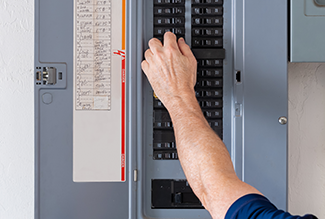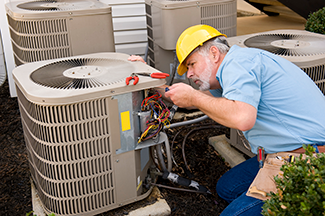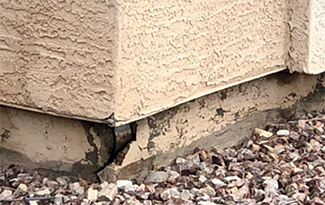What Are The Top 10 Problems Found During A Home Inspection?
What Are The Top 10 Problems Found During A Home Inspection?
There are many items of repair that could pop up during a home inspection; some major, some minor. Maybe you are living in an older house, and you'd like a thorough evaluation of the home in its current condition so you can work toward getting your home in tip-top shape for comfortable living. Perhaps you are buying/selling your home; sometimes, the seller doesn't even know some of these problems exist themselves until the buyer has the inspection completed. There are however, common problems that you are most likely to have turn up during a home inspection. We've listed the 10 most likely issues that will turn up during a home inspection:
1 | Overloaded or double-tapped circuit breakers
 Overloaded or double-tapped circuit breakers, which can cause of fire. All of the home’s wires come into the breakers, where there’s a place for one wire, or circuit, per breaker. The common problem: When two circuits are twisted into one little breaker, they overheat and create a real danger of fire.
Overloaded or double-tapped circuit breakers, which can cause of fire. All of the home’s wires come into the breakers, where there’s a place for one wire, or circuit, per breaker. The common problem: When two circuits are twisted into one little breaker, they overheat and create a real danger of fire.
The solution: Add circuits, don’t overload them. For this, you need to hire a licensed electrician, who will do a load calculation and decide how much load can pull on that circuit. Homeowners often overload circuits when they put an addition on the house. Suddenly, the home needs more capacity for electricity than it has, so the owner doubles up on a circuit.
2 | Poor water flow in the home
Poor water flow in the home. We've all been there: Somebody flushes the toilet while you’re taking a shower, and suddenly, there’s no water pressure in the shower. The causes can be corroded pipes or poor water pressure to the house.
The solution: A plumber can discover whether your pipes are clogged and can cut around it to improve water flow. Sometimes, the cure is as simple as unscrewing the screen on the faucet and removing the white limescale buildup (caused by Arizona’s notoriously hard water).
3 | Poorly performing air conditioners
 Poorly performing air conditioners. Perhaps your home’s ducts were not installed properly in the attic, and they’re kinked or too small. Gaps in the ducts in the attic or in the air handler, or a leak in the connection between a roof-mounted air conditioning system and the house can cause cool air to blow out of the house and to draw hot air in. These are mostly installation problems, but sometimes, the trouble is lack of maintenance or missing insulation. A home inspector can identify the problem.
Poorly performing air conditioners. Perhaps your home’s ducts were not installed properly in the attic, and they’re kinked or too small. Gaps in the ducts in the attic or in the air handler, or a leak in the connection between a roof-mounted air conditioning system and the house can cause cool air to blow out of the house and to draw hot air in. These are mostly installation problems, but sometimes, the trouble is lack of maintenance or missing insulation. A home inspector can identify the problem.
4 | Roof issues
Roof issues. Concrete tile is beautiful on an Arizona rooftop, but in homes that are at least seven years old, the membrane underneath the tile, which keeps the house dry can rot, tear or wear out and leak, especially if it’s made from a lower-grade paper. Often, it’s not just one tile that’s broken. When homeowners walk on the roof to do self-repairs or hang holiday lights, for instance, they break the tiles.
Tip: Learn how to walk on the tiles so they don’t break. Step on the double lap of the tile or at the valley of the tile, and walk gently; don’t stomp! Even better: Stay off of the roof. Those tiles protect the home from a lot of wear and tear from the sunshine.
5 | Broken or damaged trusses in the attic
Broken or damaged trusses in the attic. The truss is the wood that forms the triangle in your attic. It carries the weight of the plywood, shingle or tile of the roof. Trusses are strong, but if someone alters them by cutting through a member to make an air conditioning duct space, for instance, or to add an air handler, your roof could fail.
The solution: Hire a structural engineer and a licensed carpenter to re-support the trusses so everything is back to normal before any structural damage occurs and the roof starts to leak or the ceiling starts to sag.
6 | Slab damage
 Slab damage. The culprit: clay-based soil that expands and contracts when it gets wet and then dries out quickly. Water can get under the slab and cause it to lift or drop (this is called heaving and settling).
Slab damage. The culprit: clay-based soil that expands and contracts when it gets wet and then dries out quickly. Water can get under the slab and cause it to lift or drop (this is called heaving and settling).
The solution: The easy one is to prevent water from getting near your home. If the damage is extensive, however, you might have to consult a specialist on slab remediation, who can dig down to the slab and lift or lower your home to even it out again.
7 | Bad repair jobs
Bad repair jobs. These can almost always be traced back to an unlicensed contractor, so make sure the individual you hire is licensed to do the work you are hiring them to do. Structural disasters waiting to happen: a patio support column that has no strapping, undersized wood used for the roof; a patch rather than a permanent repair.
8 | Unfinished or unpermitted home additions
Unfinished or unpermitted home additions. They’re easy to spot: An enclosed carport with an air conditioning unit stuck in the wall; the outline of what used to be the garage door in a new room. Sometimes rooms don’t have heat or air conditioning systems; some don’t even have electricity. When you try to sell your home, your appraiser probably won’t count this kind of half-baked addition in the square footage, so your asking price goes down. And if you didn't get a permit for the addition, it won’t be on the tax rolls so it won’t be part of the appraised value of the home. And if your addition isn't finished, half of the drywall is up, the ceiling isn't complete, etc., get a permit and finish it. If you’re staying in the home, you’ll be more comfortable. If you’re moving, you’ll get a better price and make a better first impression on potential buyers.
9 | Lack of maintenance
Lack of maintenance. Some people do nothing to keep their homes in shape. Their front doors are rotting at the sill; their window screens are torn; the eaves around the house are faded; the exterior trim paint is down to bare wood. Those are sure signs that nobody cares about this house.
10 | The gas line is not capped
The very worst: the gas line is not capped. Without a valve, gas can leak out when it is turned on in the house. Gas goes to the water heater, furnace and stove, among other appliances. Each appliance should have a shut-off valve. Call a plumber and have them installed properly.
A home inspector doesn't fix these things; he just finds them. That’s the first step in getting your home in shape for comfortable living or for the real estate market.
###
Photo Credit
- Arizona Foundation Solutions
- Shutterstock
